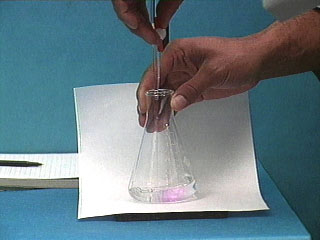
IMAGE. Close-up of a titration experiment
showing the addition of titrant from a buret into an Erlenmeyer flask.
|
A titration is a laboratory procedure for quantitative analysis. Titrametric analysis is used to determine:
the concentration of an analyte in solution
the stoichiometry of a reaction
the number of electrons gained or accepted in a redox reaction
solubility products
Typically, titrations involve two solutions: an analyte solution and a standard solution. An analyte solution is the one that is studied. The concentration of the analyte solution is often unknown. The standard solution is a solution for which the concentration and identity of the solution is known.
In a titration, one of the two solutions is added dropwise from a buret until the equivalence point or end-point
is observed. The end-point can be observed by visually observing the a change in the appearance of the solution or by recording a change in a chemical or physical property of the mixture (pH, conductivity, absorbance).
Sometimes it is convenient to add an indicator solution to the mixture before titrating. The addition of an indicator provides a dramatic color change at the end-point. An indicator compound is a reagent that will change color when the reaction is complete or when the chemical property of the solution changes. Indicator solutions are chosen on the basis of the size of the transition range (i.e., phenolphthalein changes from colorless to pink in the pH range of 8.3-10.0) and the accuracy of the transition range (phenolphthalein is accurate for the titration of an strong or weak acid with a strong base, but would not be acceptable for the titration of a weak base with a strong acid).
|